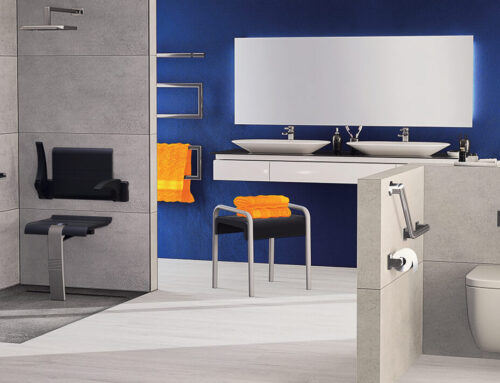Bathroom Accessibility No Longer Linked With Poor Aesthetics
The founders and forebearers of bathroom design catering to those with advancing age and physical disability commenced their product development journey in a similar way to many others designing products for a purpose: their main goal was to provide function where none existed before.
Through the passage of time and continuous improvement in the quality and availability of bathroom products, design for accessible bathroom fixtures has evolved too; both functionally into stronger, lighter materials, and aesthetically, from the once sterile, hospital-style look and feel of fittings and fixtures, into more streamlined, design-friendly materials to cater to different trends and tastes.
A change in the definition of ‘accessibility’
The social change that has taken place over the last ten to fifteen years has underpinned changes to the way we define ‘accessible’ spaces, including bathrooms.
In the past, we have considered there to be a division and separation of ‘able’ and ‘disabled’ people, which necessitated a categorisation as one or the other, and to pursue products and services that catered appropriately for those who identified as either ‘able’ or ‘disabled’.
It followed that the range of products and services available to those who categorised themselves as ‘disabled’ had a smaller range of options, proportionate to the smaller number of people making up this market segment.
The social shift over the last decade has come to recognise that ability or disability aren’t two categories, rather physical ability comes on a spectrum on which many people find themselves at various points across their lives.
What Is Universal Design?
Universal design is a now more appropriate term for product development and design principles that are focussed on catering to the broadest segment of the market: products that cater to all abilities. Universal design is accessibility at its core.
The social shift mentioned earlier has also in part been driven by commercial outcomes, where restaurants and public spaces have not only a requirement to cater to all levels of physical ability, but it’s also in their best commercial interests to do so in order to capture a wider segment of clientele.
Another factor contributing to the attitude and social shift has been the increasing cost of construction. Particularly in New Zealand where we are heavily dependent on imported goods and materials, kiwis planning and designing their spaces for longer term use need to consider their requirements across different phases of ability when making material selections in order that their spaces have the longevity to see them through. Designing and building properly once is more sustainable than revisiting bathroom design in subsequent years due to changing physical circumstances.
Why is universal design important in the bathroom?
The statistics for injuries in the bathroom are staggering, and are unfortunately on the rise. Figures from New Zealand’s entity responsible for administering the country’s no-fault accidental injury compensation scheme, ACC, show that on average, 77 people suffer from injuries originating from the bathroom each day.
This comes at a total cost of NZD $35 million each year, and the number of injuries is increasing at a rate of 13% per annum.
The market for accessible bathrooms isn’t limited to how we define our level of accessibility day-to-day, rather, we are highly likely to experience an injury at some stage of our lives that temporarily makes using the bathroom difficult or impossible. In these situations, having a considered bathroom design that strikes the right balance of function and aesthetics changes the nature of this experience drastically.
How Can We Incorporate Universal, Accessible Products Into Bathroom Design?
Incorporating products and materials that are universally designed for accessible bathrooms is a clever move, avoiding expensive renovations or retro-fitting in future and ensuring the long-term suitability of the bathroom for homeowners or occupants.
There are a few ways to commence this process that SA Plumbing Supply would recommend.
Firstly, while we’d like to think that all home and commercial design starts with longevity in mind, in reality accommodating accessibility is usually driven by an accident or diagnosis that commences this thought process.
We recommend undertaking research in order to establish what could be the best solution for your particular circumstances. For example, there is increasing research that those living with symptoms of dementia can be supported by design that incorporates colour contrasts to facilitate better orientation and perception of their environment.
Those living with rheumatic disorders have increased sensitivity to cold surfaces, which means that incorporating products such as the Warm Touch range combines the visual properties of high glass chrome surfaces with the touch and texture sensitivity requirements to create surfaces that are warmer.
Finally, a catch-all signal of universal design can be found by looking out for Lifemark Certified products, which provide a Lifemark Star Rating on how well a product will suit an individual or families needs over a lifetime.
Check out our range of accessible bathroom products for ideas, and let us know how we can help on designing and creating a bathroom that stands the test of time.




